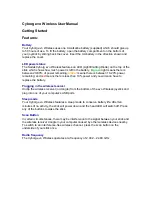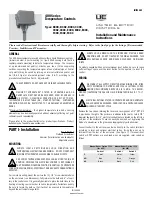
2. Safety
6
WIKA Operating Instructions High Pressure Controller, Model CPC8000-H
GB
1
4
2
3
5
9
9
3
.0
0
/0
6
/2
0
1
7
/GB
2. Safety
WARNING!
Before installation, commissioning and operation, ensure that the appropriate instrument
has been selected in terms of measuring range, design and specific measuring
conditions.
Serious injuries and/or damage can occur should these not be observed.
Further important safety instructions can be found in the individual chapters of these
operating instructions.
2.1 Intended use
The CPC8000-H is designed to automate the testing and calibration of all types of pressure devices
and instruments. Up to two removable / interchangeable pressure transducers are available in full
scale (FS) ranges from 0
…
414 bar abs up to 1600 bar abs./ 0
…
6000 psi abs up to 23200 psi abs.
Each transducer module is configured with its own calibration parameters on board and has an
accuracy down to 0,01% FS
The two transducers, in combination with the internal control valve regulator, provide a dynamic
output. The system consists of a priming system as well as a fluid reservoir. The operator can selected
the a specific transducer. There is no Autorange function. The two ranges can be chosen to optimize
uncertainty levels across the full pressure span of the instrument.
In addition to the capacity for two pressure ranges, a third, barometric transducer is installed. With this
sensor a CPC8000-H, with absolute or gauge pressure transducers, can emulate pressure of the
opposite type.
The instrument has been designed and built solely for the intended use described here, and may only
be used accordingly.
The technical specifications contained in these operating instructions must be observed. Improper
handling or operation of the instrument outside of its technical specifications requires the instrument to
be shut down immediately and inspected by an authorized WIKA service engineer.
Handle electronic precision measuring instruments with the required care (protect from humidity,
impacts, strong magnetic fields, static electricity and extreme temperatures, do not insert any objects
into the instrument or its openings). Plugs and sockets must be protected from contamination.
If the instrument is transported from a cold into a warm environment, the formation of condensation
may result in the instrument malfunctioning. Before putting it back into operation, wait for the
instrument temperature and the room temperature to equalize.
The manufacturer shall not be liable for claims of any type based on operation contrary to the intended
use.







































